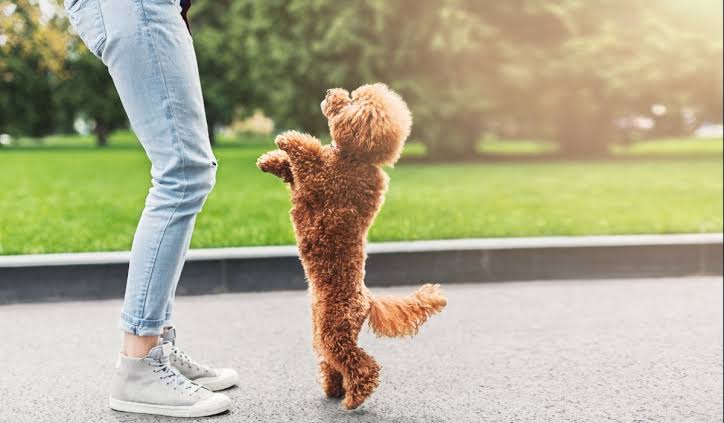
10 Fun Tricks to Teach Your Dog: Dogs are not just pets they’re intelligent companions eager to engage with their humans. Teaching your dog tricks isn’t just about showing off (though that’s fun too); it strengthens your bond, keeps your dog mentally and physically stimulated, and builds confidence. Whether your pup is a playful puppy or a seasoned senior, trick training is a fantastic way to deepen your relationship and burn off energy in positive ways.

Below are 10 fun and rewarding tricks every dog can learn, including how to teach them, what you’ll need, and why your dog will love them.
10 Fun Tricks to Teach Your Dog
1. Shake Hands (Paw)
Why it’s fun:
A classic crowd-pleaser and a simple introduction to paw-awareness and positive reinforcement.
How to teach it:
- Ask your dog to sit.
- Hold a treat in your closed fist and let your dog sniff.
- Wait—most dogs will paw at your hand out of curiosity.
- As soon as they do, say “Yes!” and give the treat.
- Add the cue word “Shake” or “Paw” as they begin to associate the behavior.
Pro Tip:
Use the same paw consistently before switching to “other paw” later.
2. Spin
Why it’s fun:
Energetic, visually engaging, and easy for most dogs to grasp.
How to teach it:
- Start with a treat close to your dog’s nose.
- Slowly move the treat in a circle around their head.
- As your dog follows, they’ll turn in a circle—say “Spin!”
- Reward the moment they complete the circle.
Pro Tip:
Teach both directions: “Spin” and “Twist” for clockwise and counterclockwise.
3. High Five
Why it’s fun:
An advanced version of “Shake,” and great for photos or impressing guests.
How to teach it:
- Ask for a “Shake” but hold your palm facing your dog.
- Encourage them to touch it with their paw.
- When they do, say “High five!” and reward.
Pro Tip:
Once mastered, turn it into a “Double High Five” for bonus flair.
4. Play Dead (Bang!)
Why it’s fun:
Super cute, especially when paired with “Bang!” and finger-gun motion.
How to teach it:
- Ask your dog to lie down.
- Hold a treat near their shoulder and slowly lure their head sideways to the ground.
- As they roll onto their side, mark with “Bang!” and reward.
- Gradually extend the time they stay “dead” before rewarding.
Pro Tip:
Use a clicker if your dog responds well to marker training for timing.
READ ALSO: How to Keep Your Dog Active During the Winter Months
5. Sit Pretty (Beg)
Why it’s fun:
Builds core strength and looks adorable.
How to teach it:
- Ask your dog to sit.
- Hold a treat just above their nose, slightly back.
- As they lift both paws off the floor, support their chest if needed.
- Mark with “Sit pretty!” and reward.
Pro Tip:
Start with soft surfaces or a wall behind them for balance support.
6. Ring a Bell
Why it’s fun:
Functional too! Great for housebreaking or learning to “ask” to go outside.
How to teach it:
- Hold a bell or button and let your dog sniff.
- When they touch it with nose or paw, say “Yes!” and treat.
- Place the bell near the door and repeat the action before walks.
Pro Tip:
Be consistent—always make the bell mean “something good happens.”
7. Targeting (Touch a Hand or Object)
Why it’s fun:
Forms the basis for many tricks, agility, or behavior shaping.
How to teach it:
- Hold out your palm and say “Touch.”
- When your dog sniffs or nudges your hand, reward.
- Over time, they’ll learn to bop your hand (or a target stick) with precision.
Pro Tip:
Expand this to touching buttons, light switches, or even closing doors!
8. Clean Up Toys
Why it’s fun:
Teaches responsibility (well, kind of) and impresses like crazy.
How to teach it:
- Teach “Take it” to pick up a toy.
- Place a toy box nearby and lure them over.
- Say “Drop it” over the box—reward when toy lands in.
- Chain commands together: “Take it… Drop it… Good job!”
Pro Tip:
Use a specific toy at first, then generalize to all toys.
9. Go to Bed (Place)
Why it’s fun:
Helps calm dogs when guests arrive or during mealtimes.
How to teach it:
- Designate a mat or dog bed.
- Lead your dog to it with a treat and say “Place” or “Bed.”
- When all four paws are on the bed, mark and reward.
- Gradually increase the time and distance.
Pro Tip:
Turn it into a game—run to the place and “settle” for a reward.
10. Walk Between Your Legs
Why it’s fun:
Fun for heelwork, photos, and canine dance routines.
How to teach it:
- Stand with legs shoulder-width apart.
- Lure your dog from behind you to walk forward between your legs.
- Say “Through!” as they step through—reward.
- Once comfortable, walk forward and repeat the cue as they walk with you.
Pro Tip:
Add this trick into dancing routines or freestyle shows for extra flair.
Benefits of Trick Training
- Mental stimulation: Prevents boredom and associated behavior issues.
- Bond building: Increases trust, communication, and fun.
- Confidence booster: Nervous dogs blossom when they master a new trick.
- Exercise alternative: Perfect for rainy days or indoor play.
- Foundation for advanced work: Great stepping stone to agility, scent work, or therapy dog training.
Training Tips for Success
- Keep sessions short – 5–10 minutes per session is ideal.
- Use high-value treats – Soft, smelly rewards are best.
- Mark behaviors clearly – Use a clicker or say “Yes!” at the exact right moment.
- Always end on a success – Even a simple sit counts.
- Be patient – Every dog learns at their own pace.
FAQs
What age should I start trick training?
You can start as young as 8 weeks! Puppies are sponges for learning. Just keep sessions short and fun. Older dogs can absolutely learn too—don’t let age be a barrier.
My dog is stubborn. Can they still learn tricks?
Yes! “Stubborn” often means your dog needs higher motivation, shorter sessions, or a clearer understanding of what you’re asking. Try different treats, toys, or even breaks between reps.
How long does it take to learn a new trick?
Simple tricks like “Shake” or “Spin” can take a few days, while complex ones like “Play Dead” may take weeks of consistency. Be patient and celebrate small progress.
Should I use a clicker or verbal praise?
Both work! A clicker offers precise timing, which helps dogs understand exactly what behavior earned a reward. Verbal markers like “Yes!” also work well—consistency is key.
What if my dog gets frustrated or loses interest?
Stop the session before frustration builds. Keep it positive and brief. Go back to something easy they already know, reward generously, and try again later.
How often should I practice tricks?
Daily 5-minute sessions are ideal. You can also sneak in practice during walks, playtime, or while watching TV—make learning part of everyday life.
My dog knows the trick at home but not elsewhere. Why?
Dogs don’t generalize well. Practice tricks in new environments (like the park, friend’s house, etc.) so your dog learns the trick works everywhere, not just in your living room.
Leave a Reply
You must be logged in to post a comment.